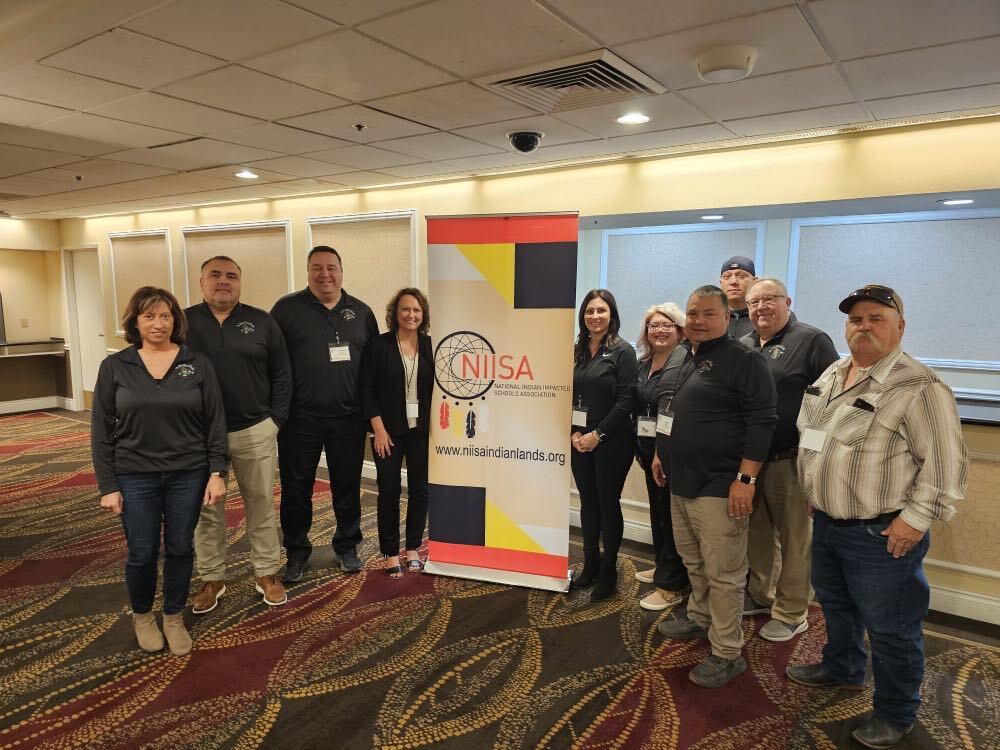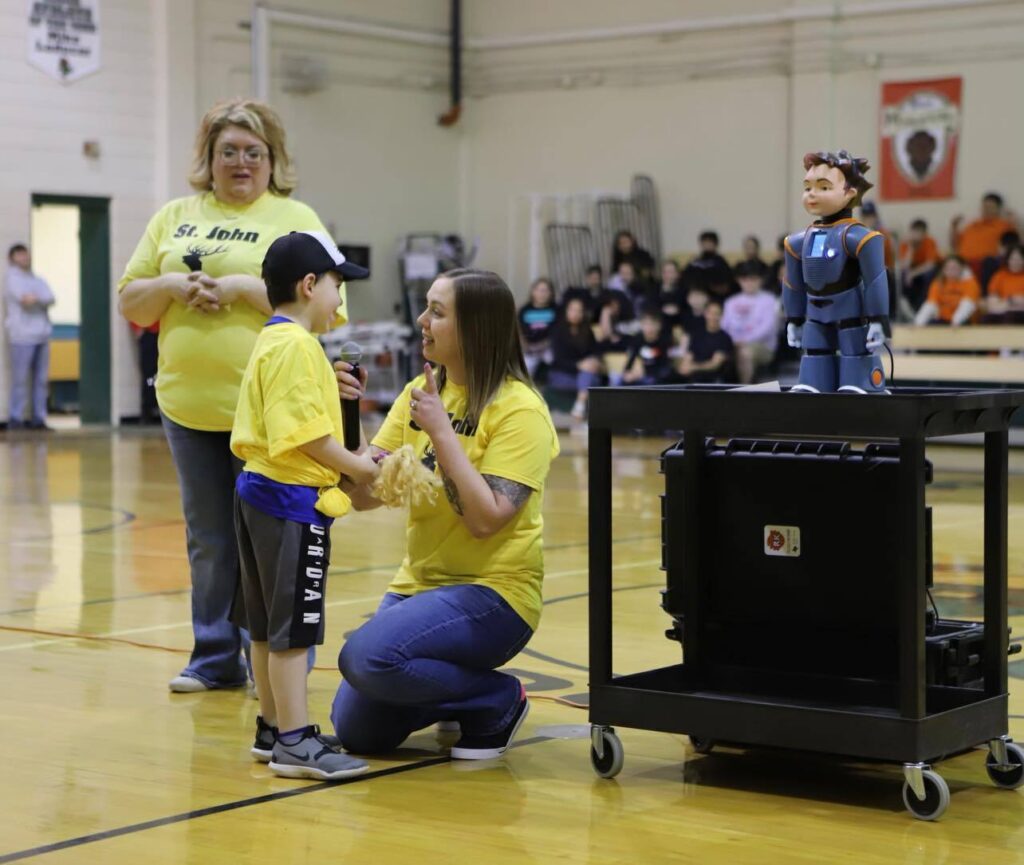News Based on facts, either observed and verified directly by the reporter, or reported and verified from knowledgeable sources.
St. John Elementary and Middle School recognized as Category One Distinguished Schools
 St. John Public School educators credit relationship-building for boosting student’s learning experience. Photo Courtesy of St. John Public Schools
St. John Public School educators credit relationship-building for boosting student’s learning experience. Photo Courtesy of St. John Public Schools
Educators help every student, every day
When a student shut down during math, Brooke Zupan, a first-grade teacher, took a moment to talk to him. He was tired and missed his mom. After making sure he was okay, she took him to a separate room to take a nap. When he woke up, he was back to his usual self.
The teacher follows the school’s motto: Every student, every day. “We have to meet the daily needs of our students and every day they’re different,” Zupan said.
St. John Elementary and Middle School, located in St. John, N.D. near the Turtle Mountain Reservation, shared a Category One Elementary and Second Education Act Distinguished School Award after exhibiting exceptional student performance and academic growth.
Two schools from every state receive the ESEA Distinguished School Award each year. This year, the St. John schools received one of the designations, and Mary Stark Elementary School in Mandan received the other. Last year, St. John High School was awarded this recognition.
National ESEA Distinguished School Program recognizes the progress and academic achievements that federally funded schools make. Schools are selected by their state agency, such as the North Dakota Department of Public Instruction. The three characteristics to determine their eligibility include having a poverty rate of 35% for the selected year, demonstrating high academic achievement and exceeding the state-determined accountability criteria.
Students moved 10% or higher in English Language Arts scores and assessments for two years in a row and moved out of targeted status, which is when schools perform at the bottom 10% of standardized testing. Results from the North Dakota State Assessment show over the course of a year, there was a 68% increase in proficiency for reading and a 39% increase in proficiency in math between third and eighth grades at the school.
According to Sherry Tandeski, the principal at St. John Elementary School, this type of academic achievement is hard in their part of North Dakota. About 26% of Rolette County’s residents live in poverty, making them one of the poorest counties in the state, according to a report by the U.S. Census Bureau. Many homes don’t have landlines or access to the internet.
While the population of St. John consists of about 320 people, around 430 students from Pre-K to twelfth grade are enrolled at the school. Students come from five surrounding towns including St. John, Rolla, Rolette, Belcourt and Dunseith. St. John Public School District #3 is located about three miles from the Canadian border and 10 miles from the Turtle Mountain Indian Reservation. Around 96% of students at the school are reported to be American Indian. Though Natives are the biggest minority population in North Dakota, 11% is the average number of enrolled American Indians across the state’s public schools.

One of the biggest setbacks for students in the district was learning loss due to the COVID–19 pandemic. St. John staff tried to work with families to accommodate them and answer questions, but remote learning was still hard for many of the school’s students.
“When Covid hit, everyone was talking about learning loss,” said Tandeski. “I knew what that looked like because a lot of our students go home to their aunties and uncles. We were expecting them [family members] to be a teacher during Covid through the online learning activities.”
Once students were able to return to school, St. John Elementary and Middle School held a reading and math intervention for six weeks during the summer. Staff planned activities like STEM workshops in the afternoon and “sprinkler sessions” – low-cost entertainment with a sprinkler connected to a garden hose – for recess on Fridays. “After Covid ended and we were able to come back, we really concentrated on what our summer school looked like,” said Tandeski. “The kids all wanted to come because they missed school and our teachers wanted to be here.”
Besides learning loss, St. John staff also noticed a lack of healthy coping mechanisms when students came back to school. St. John Middle School principal Catherine Anderson said students were more likely to be anxious and break down in the classroom.
“We’re seeing a lack of coping skills, kids knowing the skills to deal with anger issues, personal issues at home, anxiety, stress –– we’re seeing all of these, especially at a high because of Covid,” said Anderson. “I think with all these relationship pieces that we’ve taken in that initiative, we’re starting to see kids come forward and ask for help.”
Due to this need, St. John Elementary and Middle School began applying the BARR Model to their daily schedules. “Building Assets Reducing Risks,” as it’s called, is a program structured to give kids lessons on relationship building. At St. John, staff and students meet weekly to address behavior and academic needs.
St. John Public School is also the first school in North Dakota to own Milo, a humanoid robot made to assist kids with autism by learning healthy coping skills, such as taking deep breaths and cooling down through exercises. Milo collects data on his “best friends,” as he refers to the children, enabling educators to keep track of students’ emotional needs.
“We’re noticing that the relationship-building approach that we’re taking, kids are coming to us with personal challenges they are facing through surveys and conversations,” Anderson said.
The biggest game changer by far is implementing the Multi-Tier Support System, a program that tracks students’ assessment scores throughout the year. MTTS uses reading and math pathways, along with research and evidence-based curriculum to help students in this process. Students are then placed within each tier according to their Star test results. Through the tiers students are assigned to intervention programming to meet their needs.
Tandeski said since utilizing the program, students have been studying harder and completing assignments more often, which has resulted in better test scores. Zupan, who is one of the educators on the school’s MTSS team, credits not just the program but staff’s work ethic to improvements in the last few years.

“There are always issues that come up,” said Zupan. “But that is the beauty of our school. When we have a student struggling, we work together as a team and come up with a plan on how to help that student.”
Attendance remains one of the school’s biggest problems. During the pandemic, students were afraid to come to school because they feared getting the elders in their community sick. But Tandeski said relationship-building and educators taking the time to check in on students has helped encourage better attendance.
Funding is vital for continuing the progress St. John Public School has made. Professional development, poverty-trauma training and programs such as BARR are an annual expense. Money from the Comprehensive Literacy State Development Grant, North Dakota Math Grant, Stronger Connections Grant and Best in Class Grant pays for these programs, which has helped improve the quality of education at the school.
“Without these opportunities, we really would be limited in our ability to bring in some of these programs,” Anderson said.
Since staff learned of this recognition, St. John has been involving students in the celebration through assemblies and activities. “I have four children who attend this school. When they come home they’re excited,” said Zupan. “It’s nice to see what each level is doing to celebrate the success of receiving this award.”
St. John Public School will continue adjusting to meet the needs of its students. At the end of the day, Tandeski and Anderson agree the relationship the school’s educators have with their students is the most important part of their work.
“It’s not about the reading, the writing and the math,” said Tandeski. “But if that’s all you’re going to hammer, kids don’t think you care about them. When you take them under your wing, kids who normally wouldn’t be doing their reading or homework are doing it.”
Staff at St. John Public School are currently making arrangements for State Superintendent Kirsten Baesler to come and present the award at an assembly in the near future.
Sourcing & Methodology Statement:
ESEA Network. (n.d.). What Is The National ESEA Distinguished Schools Program?. National Title I Distinguished Schools. https://www.eseanetwork.org/ds
Goodman, J. (2018, December 18). How a robot named Milo helps children with autism develop social skills. Robokind. https://www.robokind.com/press-mentions/how-a-robot-named-milo-helps-children-with-autism-develop-social-skills
RethinkEd. (2023, August 29). Multi tiered system of supports professional development - rethink ed. https://www.rethinked.com/professional-development/mtss/
Same students. same teachers. better results. BARR Center. (2023, September 13). https://barrcenter.org/
St. John 3 School District. Public School Review - Established 2003. (n.d.). https://www.publicschoolreview.com/north-dakota/st-john-3-school-district/3817460-school-district#google_vignette
Targeted support and improvement. North Dakota Department of Public Instruction. (n.d.). https://www.nd.gov/dpi/districtsschools/essa/accountability-support-improvement/targeted-support-and-improvement
U.S. Census Bureau quickfacts: Rolette County, North Dakota; North Dakota. United States Census Bureau. (n.d.). https://www.census.gov/quickfacts/fact/table/rolettecountynorthdakota,ND/PST045222
Dateline:
ST. JOHN, N.D.
